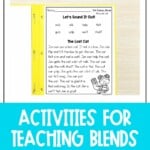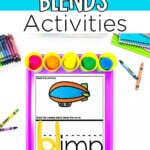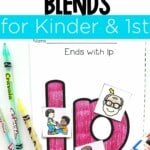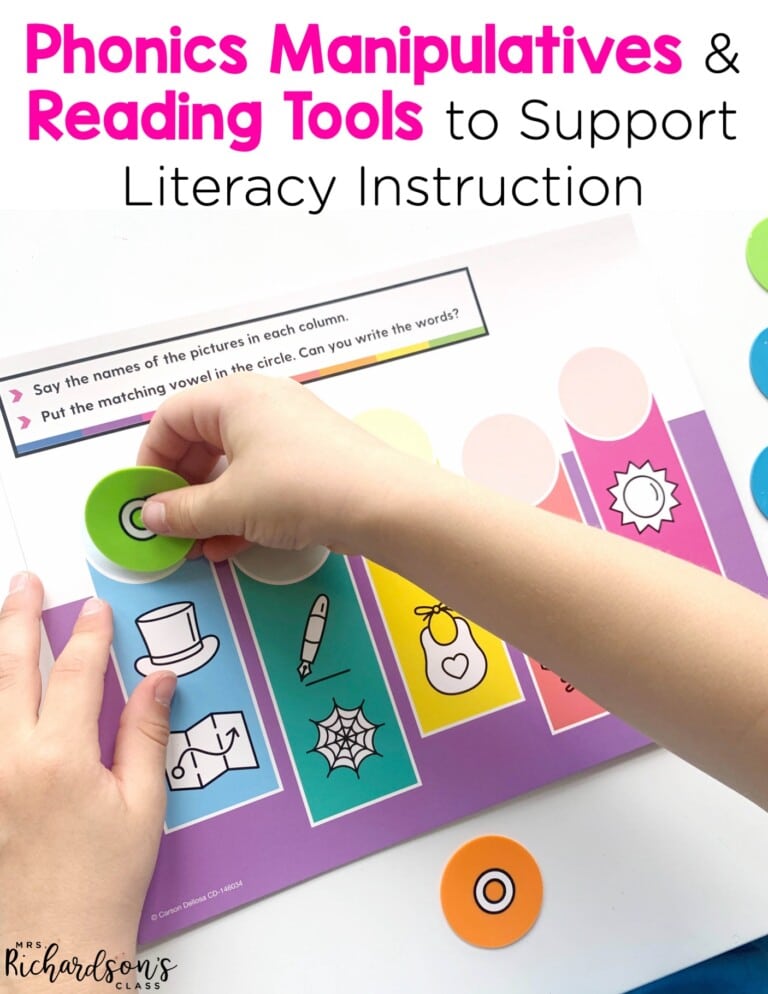


Have you ever had students who struggle to read words with blends or complete activities for blends? Maybe they read “bet” for best or “cab” for crab? This is very common for beginning readers! If you have students who know their letters and sounds and can blend and segment CVC words, they may be ready to move towards working with blends.
When it comes to teaching young students how to read, a big key to success is helping readers be able to decode words. If we take the time to help our readers build confidence and equip them with the right reading strategies and skills, they will experience success. To help you get started, I put together six different activities for blends you can use to support your readers.
One of my favorite ways to have students independently practice specific phonics skills is to use literacy centers. Students can interact with literacy manipulatives while they build blends, write blends, read blends, and more in centers. There are so many different ways you can have students work with blends.
I have a whole set of 10 blends literacy centers already done for you! From puzzles to coloring by blend, games, clip cards, building blends, and more, your students will love these hands-on centers!
Another way to incorporate blends is through digital task cards. Digital task cards, specifically Boom Learning Cards, are perfect for morning work, centers, independent practice, or intervention time. They automatically record student data so you can see how they are doing!
Plus they are so convenient to use:
You can learn more about digital task cards HERE. I have seven sets of activities you can grab HERE!
My students always loved clip card activities! They’re also a great way to squeeze in a little fine motor practice to help them with writing, too! Blends clip cards also work well in literacy centers, intervention time, and as morning work. I love how little-prep this type of activity is!
You can grab this Beginning Blends Clip Cards set with 18 cards and student recording pages. The recording pages make it easy to check their work. You can also use them as extra practice separately.
If you want an independent work option for activities for blends, sorting activities are the way to go. Students can read picture cards and determine if they have a blend and how to spell it. Then, they can glue the picture card to the blend. This activity is great for independent practice, centers, morning work, and homework.
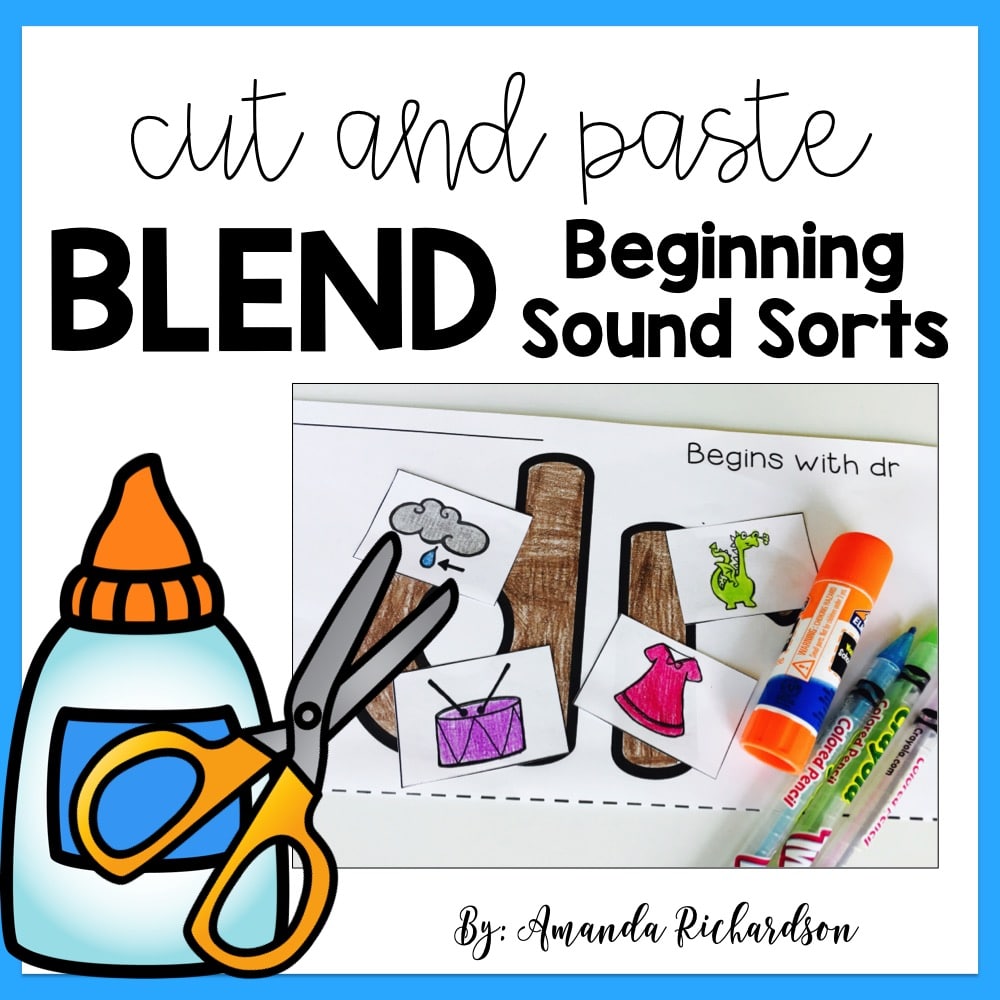

You can get Beginning Blend Sound Sorts and Ending Sound Blend Sorts to be all set with independent blends practice!
One thing I love about decodable passages is how many different ways you can use them! You could use a decodable passage as a quick informal assessment with your reading small group. You could use it as a pre-assessment to see if a student is able to decode words with that specific phonics skill. A decodable passage could also be used as a post-assessment after you have taught and worked on a phonics skill for a while.
You could also use a decodable passage after teaching a new phonics skill whole group. This will allow students more opportunities to practice the phonics skill you taught them with your support. You can also put them in a literacy center or send them home for extra practice. See? They are so versatile!
I have a set of 18 decodable passages for blends. Each passage has a word list, comprehension questions, and a dictation sentence. You can grab this resource HERE!
Another way to incorporate activities for blends is in reading small groups. You can use decodable readers with a focus on blends to give students explicit practice reading blends. Using decodable readers gives students the opportunity to practice their phonics skills in a text that is aligned to a certain skill like blends. Decodables also encourage students to attend to the text they are reading, instead of merely looking at the pictures to help them decode words.
You can get this set of Blends Decodable Readers to be set for small groups! It has:
With explicit, consistent practice, reading and writing blends will become easier and easier for your students. Then, they won’t have to use so much of their mental energy decoding blends and will be ready to move on toward the more difficult phonics skills. So give some of these activities to try and see how your readers do!

Want to use the latest research to boost your readers during small groups? This FREE guide is packed with engaging ideas to help them grow!

I’m a K-1 teacher who is passionate about making lessons your students love and that are easy to implement for teachers. Helping teachers like you navigate their way through their literacy block brings me great joy. I am a lifelong learner who loves staying on top of current literacy learning and practices. Here, you’ll find the tools you need to move your K-2 students forward!


| Cookie | Duration | Description |
|---|---|---|
| cookielawinfo-checkbox-analytics | 11 months | This cookie is set by GDPR Cookie Consent plugin. The cookie is used to store the user consent for the cookies in the category "Analytics". |
| cookielawinfo-checkbox-functional | 11 months | The cookie is set by GDPR cookie consent to record the user consent for the cookies in the category "Functional". |
| cookielawinfo-checkbox-necessary | 11 months | This cookie is set by GDPR Cookie Consent plugin. The cookies is used to store the user consent for the cookies in the category "Necessary". |
| cookielawinfo-checkbox-others | 11 months | This cookie is set by GDPR Cookie Consent plugin. The cookie is used to store the user consent for the cookies in the category "Other. |
| cookielawinfo-checkbox-performance | 11 months | This cookie is set by GDPR Cookie Consent plugin. The cookie is used to store the user consent for the cookies in the category "Performance". |
| viewed_cookie_policy | 11 months | The cookie is set by the GDPR Cookie Consent plugin and is used to store whether or not user has consented to the use of cookies. It does not store any personal data. |
